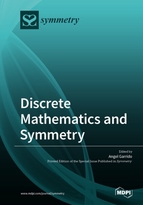Discrete Mathematics and Symmetry
A special issue of Symmetry (ISSN 2073-8994). This special issue belongs to the section "Mathematics".
Deadline for manuscript submissions: closed (30 June 2020) | Viewed by 96577
Special Issue Editor
Interests: mathematical analysis; measure theory; fuzzy measures, in particular symmetry and entropy; graph theory; discrete mathematics; automata theory; mathematical education; heuristics; artificial intelligence
Special Issues, Collections and Topics in MDPI journals
Special Issue Information
Dear Colleagues,
One of the core concepts essential to understanding natural phenomena and the dynamics of social systems is the concept of “relation”. Furthermore, scientists rely on relational structures with high levels of symmetry because of their optimal behavior and high performance. Human friendships, social and interconnection networks, traffic systems, chemical structures, etc., can be expressed as relational structures. A mathematical model capturing the essence of this situation is a combinatorial object exhibiting a high level of symmetry, and the underlying mathematical discipline is algebraic combinatorics—the most vivid expression of the concept of symmetry in discrete mathematics.
The purpose of this Special Issue of the journal Symmetry is to present some recent developments, as well as possible future directions in algebraic combinatorics. Special emphasis will be given to the concept of symmetry in graphs, finite geometries, and designs.
Contributions pursuing solutions of long standing open problems in algebraic combinatorics, as well as contributions opening up new research topics encompassing symmetry within the boundaries of discrete mathematics but with the possibility of transcending these boundaries, are welcome.
Prof. Dr. Angel Garrido
Guest Editor
Manuscript Submission Information
Manuscripts should be submitted online at www.mdpi.com by registering and logging in to this website. Once you are registered, click here to go to the submission form. Manuscripts can be submitted until the deadline. All submissions that pass pre-check are peer-reviewed. Accepted papers will be published continuously in the journal (as soon as accepted) and will be listed together on the special issue website. Research articles, review articles as well as short communications are invited. For planned papers, a title and short abstract (about 100 words) can be sent to the Editorial Office for announcement on this website.
Submitted manuscripts should not have been published previously, nor be under consideration for publication elsewhere (except conference proceedings papers). All manuscripts are thoroughly refereed through a single-blind peer-review process. A guide for authors and other relevant information for submission of manuscripts is available on the Instructions for Authors page. Symmetry is an international peer-reviewed open access monthly journal published by MDPI.
Please visit the Instructions for Authors page before submitting a manuscript. The Article Processing Charge (APC) for publication in this open access journal is 2400 CHF (Swiss Francs). Submitted papers should be well formatted and use good English. Authors may use MDPI's English editing service prior to publication or during author revisions.
Keywords
- algebraic combinatorics
- discrete mathematics
- symmetries of graphs
- symmetry in finite geometries and designs






